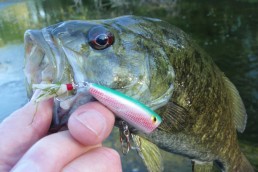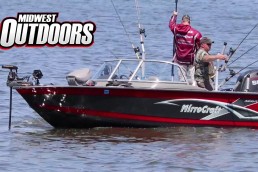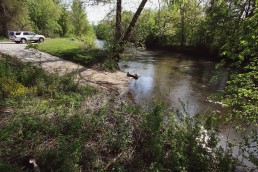The Good Ol’ Auglaize offers Great Fishing
SHARE THIS POST
If there were one river that runs through my soul, it would be the Auglaize that flows through the flatlands of northwestern Ohio. Beginning near the tiny town of Westminster, it sluggishly winds its way northward through the rich agricultural fields until it finally joins the Maumee River at Defiance. Most of my years here on this great water have been spent either camping, wading, rock skipping, carp and catfishing or waterfowl hunting.
As I passed into adulthood, the river was there for me to spend as much time near it or in it in pursuit of whatever species of fish or fowl that happened to be in season. Only in the past couple of decades did I come to realize its potential as a smallmouth fishery. And then, my angling took a turn for the better. As a result, I often pass up pond or lake fishing, pick up my waders and head for this river.
My fishing partners share the same sentiment. Here are a few methods of river angling that have proven successful for us.
We don hip boots or waders, tie wading staffs to our belts, and then work our way upstream making casts ahead of ourselves and bring our lures back with the current. River smallies face into the current, hoping to ingest any bits of food being washed along with it. By moving slowly upstream, any silt we stir up will always remain behind us so we don’t spook the fish. As we move along we search for the shale beds that line the Auglaize. Over time stress cracks the shale and crawdads hide in the cracks and then the smallmouths cruise along, rooting them out with their noses and greedily gobbling them when they try to flee. A smallmouth seen with a red, abraded snout has been doing this very thing for a long time, and an angler should choose from his gear the lures that mimic the actions of a disturbed crawdad. A Texas-rigged tube in dark green, olive green or dark brown, or a crawdad-imitating crankbait such as the Rebel Wee-Craw, can work wonders. Find the shale here and you will find the smallmouths.
Even though the Auglaize is a slower-flowing river, it does contain its share of riffles and may hold actively biting fish. The first place to cast is at the riffle’s base since any food items that wash through will wind up there. Any number of lures will work well. We begin with small crankbaits such as the great Yo-Zuri L-Minnow that mimics a small baitfish fleeing for its life. An Original Floating Rapala is also a good choice for any river. Choose it in their Shad or Crawdad color and keep it under 4 inches in length.
Are you enjoying this post?
You can be among the first to get the latest info on where to go, what to use and how to use it!
While we have caught smallies right in the fast water of a riffle, more often than not they’ll be holding on the edge of the current seam where they can lie in wait, dart into the swift water, grab a morsel, and then dart out again without expending too much energy. Often, they’re holding so tight to the edge of a current that a cast made only inches away will be ignored, while a cast right into the strike zone will be struck immediately.
Perhaps the greatest key to angling success is to move along slowly and make multiple casts to the same area. I’ve been known to take two to three hours to cover less than half a mile on the Auglaize. Every boulder, gravel point, weed bed, laydown, sandbar or shale bed is probed with a variety of lures until I find the fish or convince myself that they just aren’t biting at a particular spot.
Summer is the time to try a Pop-R and “pop” it over eddies and backwater pools where the smallies may be lying in wait. When all else fails, switch to soft plastic crawdads Texas-rigged behind a 1/16-ounce bullet sinker. Bounce them or crawl them over the bottom and past any submerged boulders. Just be ready for a strike at any time. My go-to lure is a small homemade jig spinner that consists of an 1/8-ounce jig head attached to a spinnerbait arm with either a gold willow-leaf blade or a silver Colorado blade. On the hook, I impale either a yellow or chartreuse curly-tail grub that I buy in bulk. The willow-leaf blade excels in clear water when fish are chasing minnows and the Colorado blade gets the nod in murky water when the fish “tune in to” the extra flash and vibration.
Whatever the lure or scenario, the Auglaize River is a winner in my book.
MWO
SHARE THIS POST
Did you enjoy this post?
You can be among the first to get the latest info on where to go, what to use and how to use it!
John Bennett
John Bennett is a retired history teacher, historical re-enactor, father and grandfather. As a four-season outdoorsman, his passion is waterfowl hunting and fishing for smallmouth bass. He lives in Ohio and spends quite a bit of time in his primitive log cabin, which he built.



